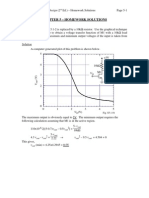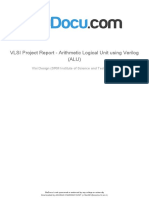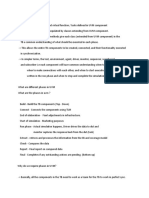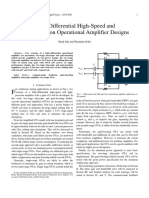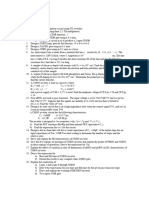0 ratings0% found this document useful (0 votes)
69 viewsAssignments Week 1 CMOS
The document contains 6 questions analyzing the characteristics and performance of a CMOS inverter circuit. It asks the student to derive expressions, explain DC characteristics with diagrams, discuss how the switching point varies with transistor ratios, calculate voltages and times for different loads, and find the maximum operating frequency. It also asks how to improve the noise margin.
Uploaded by
SHREYAS MAGAJIKONDICopyright
© © All Rights Reserved
Available Formats
Download as PDF, TXT or read online on Scribd
0 ratings0% found this document useful (0 votes)
69 viewsAssignments Week 1 CMOS
The document contains 6 questions analyzing the characteristics and performance of a CMOS inverter circuit. It asks the student to derive expressions, explain DC characteristics with diagrams, discuss how the switching point varies with transistor ratios, calculate voltages and times for different loads, and find the maximum operating frequency. It also asks how to improve the noise margin.
Uploaded by
SHREYAS MAGAJIKONDICopyright
© © All Rights Reserved
Available Formats
Download as PDF, TXT or read online on Scribd
You are on page 1/ 1
Assignment_Week_1: Analysis of CMOS Inverter
1. Derive the expression for the switching point of a CMOS inverter
2. Explain the DC characteristics of a CMOS inverter with necessary diagrams.
3. Discuss the variation in switching point of a CMOS inverter with changes in βp/βn ratio.
4. Find the ratio βp⁄βn needed to obtain an inverter midpoint voltage V M=1.3V with power supply
of VDD=3V. Assume that VTn=0.6V and VTp=-0.82V. What would be the relative device size if
K’n=110µA/V2 and the mobility values are related by µn=2.2µp. Also find the relative widths of
MOS devices.
5. An inverter uses FETs with β n=2.1 mA/V2 and βp=1.8 mA/V2. The threshold voltages are given
as VTn=0.6V & VTp=-0.7V & the power supply has a value of V DD=5V. the parasitic FET
Capacitance at the output node is estimated to be CFET = 74 fF.
a) Find the mid-point voltage VM.
b) Find the values of Rn & Rp.
c) Calculate the rise & fall times at the output when CL=0, and when CL=115fF.
d) Plot tr & tf as a function of CL
e) Find the maximum frequency of operation
6. Calculate the noise margin for a CMOS inverter operating at 3.3V with V tn=0.7V, Vtp=-0.7V,
βp=βn. What would you do to the transistor characteristics to improve the noise margin?
You might also like
- Hourglass Workout Program by Luisagiuliet 276% (21)Hourglass Workout Program by Luisagiuliet 251 pages
- The Hold Me Tight Workbook - Dr. Sue Johnson100% (16)The Hold Me Tight Workbook - Dr. Sue Johnson187 pages
- Read People Like A Book by Patrick King-Edited62% (66)Read People Like A Book by Patrick King-Edited12 pages
- Livingood, Blake - Livingood Daily Your 21-Day Guide To Experience Real Health77% (13)Livingood, Blake - Livingood Daily Your 21-Day Guide To Experience Real Health260 pages
- COSMIC CONSCIOUSNESS OF HUMANITY - PROBLEMS OF NEW COSMOGONY (V.P.Kaznacheev,. Л. V. Trofimov.)94% (212)COSMIC CONSCIOUSNESS OF HUMANITY - PROBLEMS OF NEW COSMOGONY (V.P.Kaznacheev,. Л. V. Trofimov.)212 pages
- Donald Trump & Jeffrey Epstein Rape Lawsuit and Affidavits83% (1016)Donald Trump & Jeffrey Epstein Rape Lawsuit and Affidavits13 pages
- The 36 Questions That Lead To Love - The New York Times94% (34)The 36 Questions That Lead To Love - The New York Times3 pages
- The 36 Questions That Lead To Love - The New York Times95% (21)The 36 Questions That Lead To Love - The New York Times3 pages
- Jeffrey Epstein39s Little Black Book Unredacted PDF75% (12)Jeffrey Epstein39s Little Black Book Unredacted PDF95 pages
- The 4 Hour Workweek, Expanded and Updated by Timothy Ferriss - Excerpt23% (954)The 4 Hour Workweek, Expanded and Updated by Timothy Ferriss - Excerpt38 pages
- Assignment 7 System Design Through VERILOG - Unit 8 - Week 7 - Test BenchesNo ratings yetAssignment 7 System Design Through VERILOG - Unit 8 - Week 7 - Test Benches4 pages
- PMOS, NMOS and CMOS Transmission Gate Characteristics.No ratings yetPMOS, NMOS and CMOS Transmission Gate Characteristics.13 pages
- An Introduction To Functional Verification of I2C Protocol Using UVMNo ratings yetAn Introduction To Functional Verification of I2C Protocol Using UVM5 pages
- Verilog Labs: Introduction To Lab ExercisesNo ratings yetVerilog Labs: Introduction To Lab Exercises9 pages
- Solved ISRO Scientist or Engineer Electronics 2009 Paper With SolutionsNo ratings yetSolved ISRO Scientist or Engineer Electronics 2009 Paper With Solutions22 pages
- Implementing Communication Bridge Between I2C and APBNo ratings yetImplementing Communication Bridge Between I2C and APB4 pages
- L293D Motor Driver Module Arduino TutorialNo ratings yetL293D Motor Driver Module Arduino Tutorial7 pages
- ECC508 Electronics Engineering Lab - II - VLSINo ratings yetECC508 Electronics Engineering Lab - II - VLSI40 pages
- Vlsi Project Report Arithmetic Logical Unit Using Verilog AluNo ratings yetVlsi Project Report Arithmetic Logical Unit Using Verilog Alu7 pages
- VLSI Design Lab UE17EC256: 3 Cycle ExperimentsNo ratings yetVLSI Design Lab UE17EC256: 3 Cycle Experiments12 pages
- Chapter 8 - Comparators (1.3MB) - Analog ICNo ratings yetChapter 8 - Comparators (1.3MB) - Analog IC42 pages
- Assignment 8 System Design Through VERILOG - Unit 9 - Week 8 - Case StudiesNo ratings yetAssignment 8 System Design Through VERILOG - Unit 9 - Week 8 - Case Studies3 pages
- Implementing 7 4 Hamming Code Encoding and Decoding System Using CPLD IJERTV2IS70300No ratings yetImplementing 7 4 Hamming Code Encoding and Decoding System Using CPLD IJERTV2IS703006 pages
- M.tech VLSI SEM II MID I ImportantQuestionsNo ratings yetM.tech VLSI SEM II MID I ImportantQuestions13 pages
- Radix-4 Modified Booth's Multiplier Using Verilog RTLNo ratings yetRadix-4 Modified Booth's Multiplier Using Verilog RTL10 pages
- Application of Computer Architecture and Organisation Using DE2 BoardNo ratings yetApplication of Computer Architecture and Organisation Using DE2 Board4 pages
- 9A04706 Digital Design Through Verilog HDL PDFNo ratings yet9A04706 Digital Design Through Verilog HDL PDF4 pages
- D. Text Based: The Time Period For The Clock #10 Clock ClockNo ratings yetD. Text Based: The Time Period For The Clock #10 Clock Clock5 pages
- Fully-Differential High-Speed and High-Precision Operational Amplifier DesignsNo ratings yetFully-Differential High-Speed and High-Precision Operational Amplifier Designs9 pages
- Advanced VLSI Architecture Design For Emerging Digital SystemsNo ratings yetAdvanced VLSI Architecture Design For Emerging Digital Systems78 pages
- Design and Verification of Uart Using Verilog HDL: Kumari Amrita, Avantika KumariNo ratings yetDesign and Verification of Uart Using Verilog HDL: Kumari Amrita, Avantika Kumari5 pages
- 8255 (Programmable Peripheral Interface)No ratings yet8255 (Programmable Peripheral Interface)6 pages
































